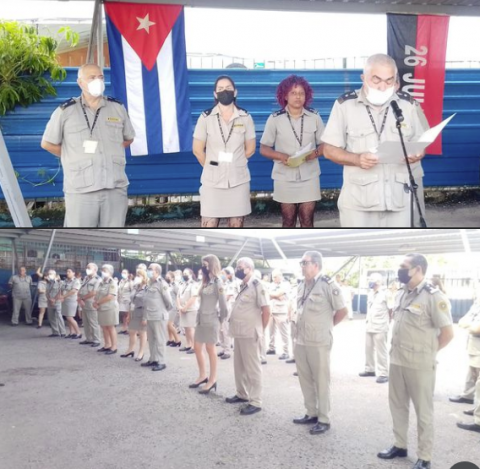
It is impossible to approach the history of Cuba without referring to the figures of Antonio Maceo Grajales and Ernesto Guevara de la Serna. Two men who, despite having lived in different times, tirelessly fought against all forms of colonialism, even sacrificing the most precious thing: family and their very existence. Maceo and Che, as they are commonly called, constitute a paradigm for all peoples who aspire to or fight for the consolidation of their sovereignty.
Antonio Maceo Grajales was born on June 14, 1845 in the city of Santiago de Cuba. During his childhood and youth he attended the first studies, acquiring an elementary culture, assumed the administration of the farm belonging to his family and dedicated himself to the commercialization of agricultural products. Two days after the uprising of October 10, 1868, he joined the Ten Years' War (1868-1878). His courage, courage, discipline and skills as a military strategist enabled him to reach the rank of Major General and occupy important positions within the command structure of the Liberation Army in the Oriente region, all this despite existing racial and class prejudices. into the independence camp.
On March 15, 1878, Antonio Maceo carried out the Baraguá Protest, where he informed the Spanish military high command of his opposition to the Zanjón Pact -a document that proposed the establishment of peace without contemplating the independence of Cuba, nor the abolition total slavery - and their decision to continue the fight. Despite this, the eastern general could not prevent the failure of the Ten Years' War. During the period of the Fruitful Truce (1878-1895) he remained, for the most part, abroad, settling in different nations of the American continent. Throughout those years, several failed attempts were linked or organized to put an end to Spanish colonialism in the Greater Antilles. In 1893 he joined the revolutionary project of José Martí and returned to Cuba at the beginning of 1895, in an expedition led by Flor Crombet.
During the Necessary War (1895-1898), Antonio Maceo held the position of Lieutenant of the Liberation Army and assumed command of the Invading Column, which departed from Mangos de Baraguá (East) and reached Mantua (Pinar del Rio), carrying carried out the feat of extending the struggle to all of Cuba. Throughout this feat, the eastern general, once again, displayed his virtues as a military cadre and guarantor of order and discipline of the Mambisa troops. He fell fighting on December 7, 1896 in San Pedro, Havana. In this way the life of the Bronze Titan ended, who participated in more than 600 combats and received 26 war wounds.
Meanwhile, Ernesto Guevara de la Serna was also born on June 14, but in 1928 in Rosario, Argentina. Throughout his childhood and youth he maintained regular contact with the rural environment and studied different studies until he obtained a medical degree. During those years, too, he traveled to several Latin American countries and came into contact with different progressive figures and forces on the continent. Once settled in Mexico, he met Fidel Castro and quickly sympathized with the cause of the July 26 Revolutionary Movement. The young Argentine was part of the 82 Granma yacht expeditionaries who landed in Cuba and was one of the survivors of the Alegría de Pío battle, December 5, 1956.
Once the insurrectionary struggle against the dictatorship of Fulgencio Batista began, Ernesto Guevara showed his qualities for guerrilla warfare, which earned him the appointment of commander and the command of troops, at the head of which he developed several fighting in the eastern region. Later he assumed command of the Invading Column number 8, Ciro Redondo and carried out the feat of, in just 47 days and under constant siege by the enemy, moving from the Sierra Maestra (East) to the Escambray massifs (Las Villas ), where he established coordinated action agreements with existing anti-Batista guerrilla forces in the center of the Island and developed a successful campaign in the region that culminated in the capture of the City of Santa Clara on January 1, 1959.
After the military defeat of the Batista dictatorship, Fidel Castro called for a Revolutionary General Strike and ordered Ernesto Guevara to march towards Havana, who arrived in the capital on January 3, 1959 and occupied the Fortress of San Carlos de The Cabin. Later he assumed different responsibilities in the direction of the country, such as: president of the National Bank of Cuba, military chief of the Western region, Minister of Industries, among others. In the mid-sixties he moved abroad to promote the guerrilla struggle in the Congo and Bolivia, a nation in which he was assassinated on October 9, 1967, becoming a symbol of international revolutionary struggle worthy of a Guerrilla fighter. Heroic.
The points in common between these two great men are multiple. The wealthy social origin, the strict family education combined with the studies and the contact with the rural environment that contributed to the formation of a character and physical condition. The trips through the American continent made possible the structuring of a Latin Americanist system of thought that in the case of Antonio Maceo focuses more on the Antillean context and in Ernesto Guevara transcends internationalism. Both figures are worthy exponents of revolutionary intransigence and radicalism, immortalized through the expression of the Bronze Titan during the Baraguá Protest: "Keep that document, we do not want to know about it" and the documentary material where the Heroic Guerrilla expresses : "Imperialism, not a little like that."

Leave your comment